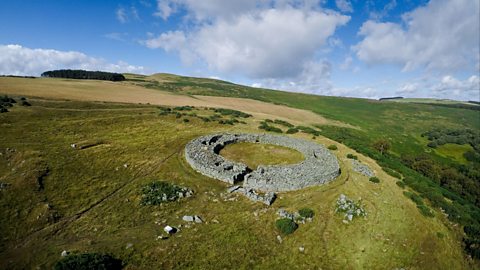It is so easy to take the roads which help us get around the world for granted - whether they are in our own country or abroad.
But while ordinary streets are here, there and everywhere, there are also many extraordinary roads all over the world.
Some of them will make us smile, while others will make us gasp - and doubt the evidence of our own eyes.
Here, BBC Bitesize takes you on a remarkable journey, so please fasten your seatbelt for an incredible ride along some incredible roads.
Atlantic Ocean Road: Driving on a rollercoaster
Wow! This isn't any old bridge, is it?
It's the Storseisundet Bridge - the most famous of the eight bridges along Norway’s Atlantic Ocean Road.
The route's most photographed bridge, it is 260 metres (850ft) long and gives the impression of being more like a rollercoaster - or, at least, a rollercoaster that has been bent out of shape!

The road, also known simply as the Atlantic Road, is five miles long, connects the towns of Kristiansund and Molde in Fjord Norway - and links Averøy island with the mainland via a series of small islands and inlets.
One of the country's 18 designated national scenic routes, it has been described as beautiful - but also treacherous, due to its twists, turns, bends and dips.
The road was opened in 1989, and tourists are encouraged to take their time driving along it by parking at one of its designated stopping places and taking in the stunning scenery.
Guoliang Tunnel: Determination in the mountains
This is a stretch of road where it pays to look ahead, rather than down.
Or maybe it would just be best to avoid it altogether.
But why was the Guoliang Tunnel built in the first place? The people who lived in the isolated cliff top village of Guoliang - 1,700 metres (5,577 feet) up in China's Taihang Mountains - were unhappy that their village was only reachable by climbing steep cliffs and then a series of stone steps.
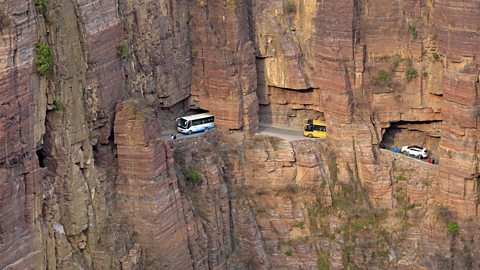
So, in 1972, a group of locals began building the 1.2km (0.75 miles) tunnel themselves - an incredible feat which took them five years.
Their new route measured just four metres (13ft) wide and has proved to be particularly dangerous to navigate after heavy rain. The tunnel's stone face, meanwhile, features 30 "windows" which give glimpses of the valley far below.
The tunnel and the village now attracts intrepid visitors from around the world.
The Magic Roundabout: Sending drivers round in circles
Sometimes on a car journey it feels like you’re simply going around in circles - welcome to Swindon's world-famous Magic Roundabout!
This isn't just one roundabout, because it's made up of five mini roundabouts encircling a central island.
It opened in 1972 and was initially called County Islands by the local authority. But the people of Swindon began referring to it affectionately as the Magic Roundabout in tribute to the BBC children's programme of the same name, which ran from 1965 to 1977.
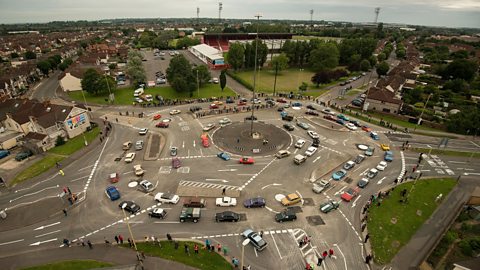
Eventually, in the early 1980s, its nickname became its official name - thanks to David Glaholm, who introduced a motion formalising the name change during his time as a councillor in Swindon.
He said: "I'm just pleased that the name 'Magic Roundabout' has spread around the world, which means the name 'Swindon' has travelled around the world too."
Mr Glaholm was speaking in September 2024, after the Magic Roundabout was announced as the winner of the UK Roundabout of the Year award. UK Roundabout Appreciation Society chairman Kevin Beresford paid tribute to it, saying: "Something just amazing happens when you approach it. You're dazzled by all this choreography of cars."
Lombard Street: The most crooked road in the world?
"And then just go around this corner…and then this one…and now this one…"
Lombard Street is, indeed, a long and winding road.
Few visitors to San Francisco can resist taking a look at what locals call 'the crookedest street in the world' - even if they don't fancy driving around its eight sharp hairpin bends.
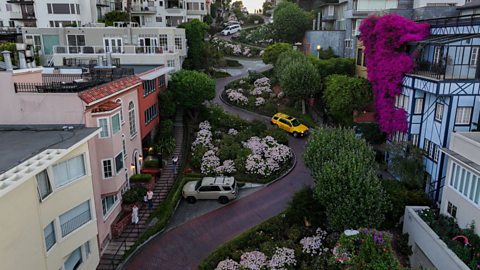
But Lombard Street offers more than these twists and turns - it boasts beautiful mansions, perfectly manicured landscaping and flowers, and, as such, is regarded as one of the city's most scenic streets.
Tourists desperate to capture it on camera are spoilt for choice and will often cover all bases by taking a photograph at the bottom - looking up at all the cars negotiating those hairpin bends - and from the top, looking out also onto San Francisco Bay, the Bay Bridge and Coit Tower.
The street, which was designed in the 1920s, had a daunting incline of 27% - and the zigzagging 'switchbacks' were created to reduce the hill's natural gradient to a more manageable 16%, thereby making it less daunting and dangerous for motorists and pedestrians.
Chapman's Peak Drive: A good spot for a car advert
Chapman's Peak Drive, affectionately known as 'Chappies' to Cape Town residents, is regarded by many as one of the most beautiful stretches of road on the planet.
It takes motorists on a 9km (5.6 miles) winding route from Hout Bay to Noordhoek, and its numerous stopping off points allow tourists to take in breathtaking views of the shoreline, and across the Atlantic Ocean. In the 1990s, it was used for television adverts promoting cars, and was closed intermittently over a decade-long period for safety reasons related to rock falls, but a civil engineering revamp saw it reopen in late 2009.
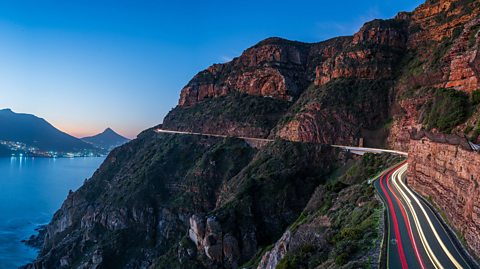
Chapman's Peak, which looms over the road, was named after John Chapman, who was the Captain's mate on the English ship The Consent. In 1607 the ship's skipper sent pilot Chapman to row ashore from what is now Hout Bay in the hope of finding provisions. The pilot later recorded this visit as being to "Chapman's Chaunce (chance)" and the name stuck.
Construction got underway on Chapman's Peak Drive in 1915, and its first section opened in 1919 - with the road finally completed three years later. It was opened to traffic on 6 May 1922 by the Governor of the Union of South Africa, His Royal Highness Prince Arthur of Connaught.
Baldwin Street: Officially the world's steepest road
In the battle to be named the world's steepest street, Baldwin Street in Dunedin, New Zealand led the way for many years.
But then, in June 2019, after more than a decade of lording it over every other street, Baldwin Street had to bow down to Ffordd Pen Llech in Harlech, Gwynedd, Wales, when the latter was named the world's steepest street by Guinness World Records (GWR) - only for the outcome of a formal review to then hand back the title to Baldwin Street in April 2020.

Following an appeal by Baldwin Street representatives, it was decided that measurements for the record title would follow a road's centre line.
The Harlech street was therefore downgraded to a gradient of 28.6%, meaning Baldwin Street - with a gradient of 34.8% - had the title back.
GWR editor-in-chief Craig Glenday said: "We're very grateful to the Baldwin Street appeals team, led by surveyor Toby Stoff, for making us aware of a rare gap in our stipulations and we're pleased to see the title return to New Zealand. We're also very grateful to the Ffordd Pen Llech team for their application and good humour throughout this process."
This article was published in January 2025
Looking for quizzes, amazing stories and fun facts?
Bitesize Topical has it all!

Can you guess the natural landmarks from the aerial photos?
Do you know your caves from your trenches? Take a look at these aerial photos and see if you can figure out which natural landmarks they are.

The unusual street names that turn peoples’ heads
Would you like to live on Candy Castle Road, or take a stroll down Goosedubbs?

Six hidden ruins that can be found across the UK
Ancient Roman bridges in Yorkshire, cottages in Wales - and a secluded church in the heart of London
